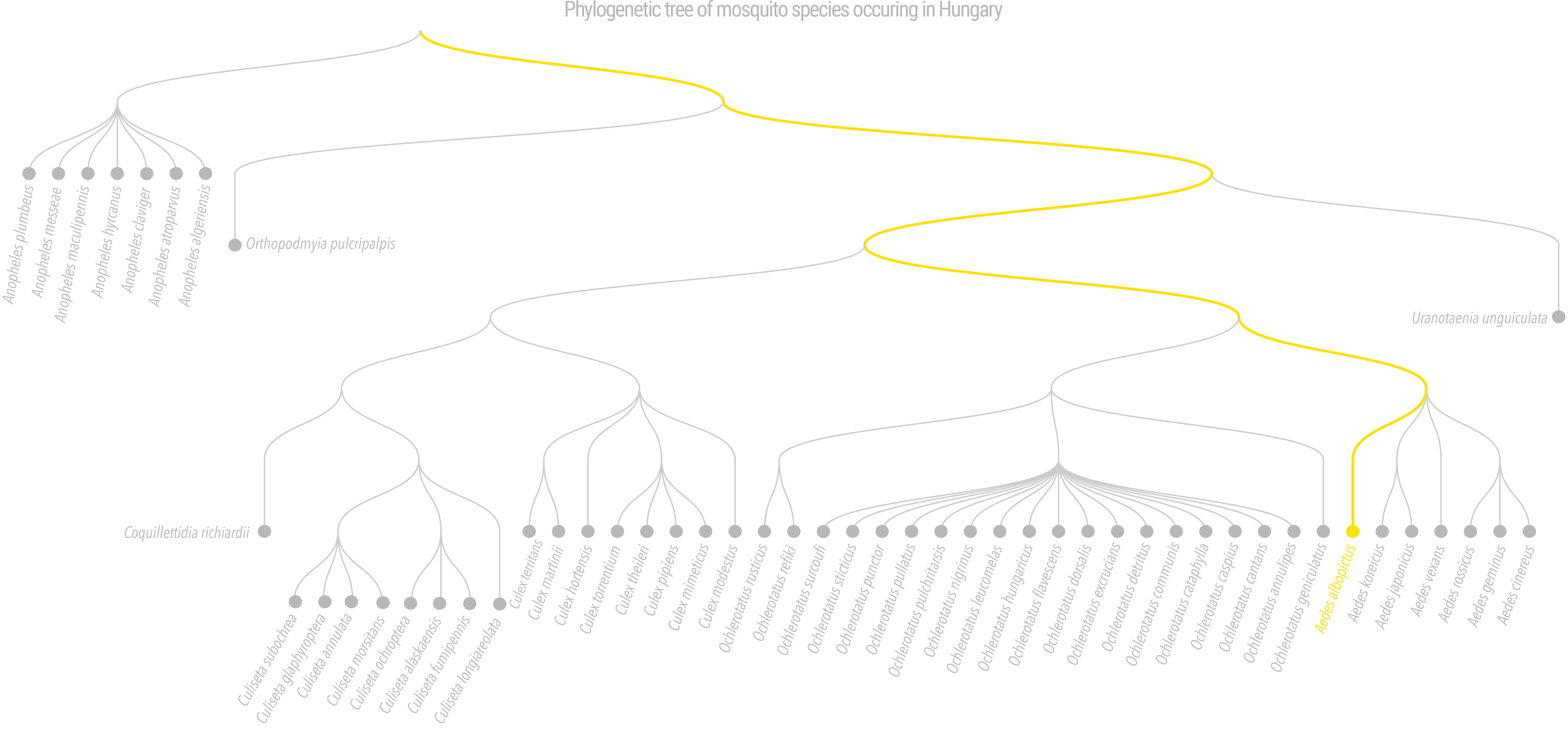ASIAN TIGER MOSQUITO
ASIAN
TIGER MOSQUITO
AEDES ALBOPICTUS
MORPHOLOGY
The Asian tiger mosquito is easily distinguishable from other mosquito speciessince it is very contrasting in color: it is a small black mosquito, around 5 mm in length, with bright white or silvery scales forming patches and stripes on its body and legs.There are no other similar-looking species in the Hungarian fauna, except for the tree hole mosquito, but the latter has no white rings on the legs. The most prominent feature of the adult tiger mosquito is a single white line on the back of the head and chest, which distinguishes it from all other species. The eggs are ca. 1 mm long and have a dark brown or black color. The males can be easily distinguished from females since they have bushier antennae while the antennae of females are thinner and simpler.

ORIGIN AND DISTRIBUTION RANGE
The Asian tiger mosquito is native to Southeast Asia, but in the last three decades, it has been introduced to many parts of the world, including Europe, thanks to global freight transport and tourism that allowed the species’ passive expansion and contributed to its invasion. The eggs of this species can tolerate cold and drought, thus the species can reach great distances by the transport of used tires and plants (e.g. in the container of lucky bamboos), the latter played the main role in the species’ emergence in Belgium, the Netherlands, and California. Although Aedes albopictus was first reported in Europe in 1979, public or private transport from heavily infested areas has also resulted in the passive transportation of the species into new areas. By the time of its first detection in Italy, it has spread to almost the entire country in areas below 600 m a.s.l. and Italy had become the most infected country in Europe. Passive transport from heavily infested areas, like Italy, via ground vehicles, is believed to be the route of introduction of Ae. albopictus e.g. into southern France, Germany, the Balkans, the Czech Republic, Spain, and Switzerland. . Albania. As a result of the tiger mosquito’s rapid dispersion, the species was reported from France and Belgium in 1999 and 2000 respectively, and since then its presence was verified in many other European countries: Bosnia and Herzegovina, Bulgaria, Croatia, Georgia, Germany, Greece, Malta, Monaco, Montenegro, Romania, , San Marino, Slovakia, Slovenia, , Turkey, and the Vatican have also reported its emergence. However, the appearance does not necessarily mean the establishment of the species everywhere, the main limiting factor is the cold winter, thus in the Netherlands, for example, it can overwinter in greenhouses only. In Hungary, it was first reported in 2014 near Baja, then in the following years, it was catched several times near the southwestern border, but its range continued to expand.
ECOLOGY
Tropical and subtropical populations are active throughout the year with nodiapausing phase. However, the populations living in temperate climates, are affected by seasonal temperature and and photoperiodicity. Eggs laid during late summer or early autumn, when daylight hours are reducing, enter facultative diapause, and hatching suppression occurs which is usually sufficient for them to survive the winter. This ability allows the species to overwinter in temperate regions and assists its dispersal in Europe. The tiger mosquito can adapt well to the different climate: diapausing eggs of European tiger mosquitoes are able to survive a cold spell of -10°C, whereas eggs of tropical populations could only survive -2°C. . Italian populations are showing signs of cold-acclimation as adults (imago), meaning they can remain active throughout winter. The tiger mosquito can breed in natural and artificial habitats as well. When the female is ready to lay eggs, it searches for water bodies that have no contact with the soil: these can be tree holes or cavities in a rock filled with water but rainwater containers or junk with accumulated water can be suitable as well. The eggs are laid on the side of the hole or container above the water level and they will hatch only when the water’s level rises due to rainfall.
The feeding strategy of the tiger mosquito is opportunistic meaning they bite humans as well as domestic and wild animals, reptiles, birds, and amphibians. However, laboratory studies and blood-meal analyses have shown a preference for human blood.
TRANSMISSION OF PATHOGENS
As mentioned before, blood hosts include humans and various animals as well, which means it has a significant role in the transmission of pathogens from animals to humans. There are at least 22 arboviruses (arthropod-borne viruses) that had been isolated from tiger mosquitoes in laboratory tests so far. The most important of these viruses concerning risk for public health are the dengue virus (causing breakbone fever), yellow fever virus, West Nile virus, and the Japanese encephalitis virus. Besides, during the 2006-2007 chikungunya outbreak in Italy, the tiger mosquito was identified as the main vector involved in the epidemic. The tiger mosquito is known also as a potential vector of the Zika virus, and it has a role in the transmission of filarial nematodes , e.g. Dirofilaria immitis and D. repens as well, that cause heartworm disease and subcutaneous dirofilariosis in dogs and wild canids, but which can also affect humans.
HOW TO DISTINGUISH IT FROM OTHER INVASIVE SPECIES?
The specimens are pitch black with bright white or silvery scales forming patches and stripes on its body. A single sharp white line is visible on the upper (dorsal) part of the thorax, while the Asian bush mosquito and the Korean mosquitos bear yellowish markings here. On both sides of the abdomen, there are white patches and markings, the legs are also black with white rings on the tarsomeres, and the tips of the labial palps are also white.